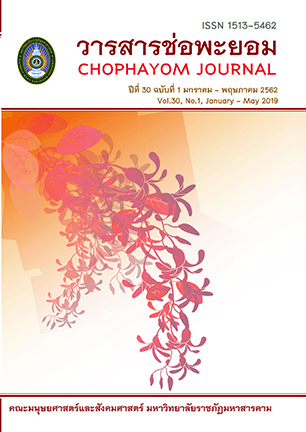The Development of Administration model for STEM Education Under the Office of the Secondary Education Service Area 27
Keywords:
Administration model for STEM EducationAbstract
This research study has two objectives: 1) to identify factors and the indicators of administration for STEM education under the Office of the Secondary Education Service Area 27. 2) to investigate its ideal situation of administration for STEM education under the Office of the Secondary Education Service Area 27. The study consisted of two steps. In the first step, five experts were selected using the purposive sampling in order to identify both the factors and indicators of administration for STEM education under the Office of the Secondary Education Service Area 27. In the second step, the researcher used the stratified random sampling in order to select 260 samples from various groups as follows: school directors, deputy directors department
of Academic Affairs, heads of science department, heads of mathematics department, heads of career and technology department from educational institutions under the Office of the Secondary Education Service Area 27. After that, analysis of current situation, ideal situation and needs assessment as a guide to the study best practice for the development of administration model for STEM education under the Office of the Secondary Education Service Area 27. The tools used in the research are the evaluation form, of identify factors, the indicators and questionnaire. The statistics used in the research were the Mean, Standard Deviation and the PNI. The results showed that: 1) there were seven factors and 43 indicators of administration for STEM education under the Office of the Secondary Education Service Area 27. The first
factor were policy formulation and organization planning, the second factor was curriculum
development, the third factor was the development of teachers’ performance, the fourth factor was learning administration, the fifth factor were supervision and evaluation, the sixth factor was networking for development and the last factor were research and development. The results of the assessment of suitability and feasibility of administration for STEM education under the Office of the Secondary Education Service Area 27 were at the highest level. 2) The current situation of administration for STEM education under the Office of the Secondary Education Service Area 27 was at moderate level ( = 3.40, S.D. = 1.04) and the level of ideal situation of administration for STEM education at high (
= 4.49, S.D. = 0.67). In order of modified Priority Need Index (PNI) from most to least were networking for development, research and development, curriculum development, learning administration, supervision and evaluation, the development of teachers’
performance and policy formulation and organization planning, respectively. Keywords : Administration model for STEM Education
References
กระทรวงศึกษาธิการ.
ทองอินทร์ วงศ์โสธร และ ธิติรัตน์ วิศาลเวทย์. (2549). “แนวคิดและหลักการเกี่ยวกับการวางแผน”
ประมวลสาระชุดวิชานโยบายและการวางแผนการศึกษา. นนทบุรี : สำนักพิมพ์
มหาวิทยาลัยสุโขทัยธรรมาธิราช สาขาวิชาศึกษาศาสตร์.
ประวิต เอราวรรณ์. (2545). การวิจัยปฏิบัติการ. กรุงเทพมหานคร : บริษัท สำนักพิมพ์ดอกหญ้าวิชาการ.
พรทิพย์ ศิริภัทราชัย. (2556). STEM Education กับการพัฒนาทักษะในศตวรรษที่ 21. วารสารนักบริหาร
Executive Journal, 3(2), 49-56.
มนตรี จุฬาวัฒนทล. (2556). การศึกษาวิทยาศาสตร์ เทคโนโลยี วิศวกรรมและคณิตศาสตร์หรือ
สะเต็มศึกษา. วารสารสมาคมครูวิทยาศาสตร์ คณิตศาสตร์และเทคโนโลยีแห่งประเทศไทย,
19, 3-14.
ศูนย์สะเต็มศึกษาแห่งชาติ. (2558). คู่มือเครือข่ายสะเต็มศึกษา. กรุงเทพฯ : สถาบันส่งเสริมการสอน
วิทยาศาสตร์และเทคโนโลยี กระทรวงศึกษาธิการ.
สงัด อุทรานันท์. (2530). การนิเทศการศึกษา : หลักการ ทฤษฎี และปฏิบัติ (ฉบับปรับปรุงเพิ่มเติม).
พิมพ์ครั้งที่ 2. กรุงเทพมหานคร : โรงพิมพ์มิตรสยาม.
สถาบันสงเสริมการสอนวิทยาศาสตร์และเทคโนโลยี. (2559). คู่มือจัดกิจกรรมสะเต็มศึกษา ระดับชั้น
มัธยมศึกษาปีที่ 1-3. กรุงเทพฯ : องค์การค้าของ สกสค.
สุทธิดา จำรัส. (2560). สะเต็มศึกษาบนเส้นทางวิชาการรับใช้สังคม : จุดเปลี่ยนการเรียนรู้สู่อนาคต.
วารสารศึกษาศาสตร์ปริทัศน์, 31(3), 34-47.
สุวิมล ว่องวานิช. (2549). การวิจัยปฏิบัติการ. กรุงเทพฯ : สำนักพิมพ์แห่ง จุฬาลงกรณ์มหาวิทยาลัย.
สำนักงานเขตพื้นที่การศึกษามัธยมศึกษา เขต 27. (2560). รายงานสำนักงานเขตพื้นที่การศึกษามัธยมศึกษา
เขต 27. สืบค้นเมื่อ วันที่ 7 กันยายน 2560, จาก https://www.secondary27.go.th .
สำนักงานเลขาธิการสภาการศึกษา. (2559). รายงานการวิจัย เพื่อจัดทำข้อเสนอนโยบายการส่งเสริมการจัด
การศึกษาด้านสะเต็มศึกษาของประเทศไทย. สืบค้นเมื่อ วันที่ 9 มกราคม 2561, จาก
https://backoffice.thaiedresearch.org .
สำนักบริหารงานการมัธยมศึกษาตอนปลาย. (2558). แนวทางการจัดทักษะการเรียนรู้ในศตวรรษที่ 21
ที่เน้นสมรรถนะสาขาวิชาชีพ. สืบค้นเมื่อ วันที่ 16 พฤษภาคม 2560. จาก https://www.
secondary11.go.th/2016.
หน่วยศึกษานิเทศก์ กรมสามัญศึกษา. (2539). แนวทางการนิเทศการศึกษา กรมสามัญศึกษา.
กรุงเทพมหานคร : หน่วยศึกษานิเทศก์ กรมสามัญศึกษา.
Dejarnette. (2012). America’s children: providing early exposure to STEM (science,
technology, engineering and math) initiatives. Education, 133(1), 77–84.
Harris, Ben M. (1985). Supervisory behavior in education. 3rd ed. Englewood Cliffs :
Prentice-Hall.
Miner,John B. (1979). The management process : theory, research and practice. New
York : Macmillan Publishing Company, Inc.
President’s Council of Advisors on Science and Technology. (2010). Report to the
President “Prepare and Inspire: K-12 Education in Science, Technology,
Engineering, and Math (STEM) for America's Future. Retrieved 12 September
2017. from https://stelar.edc.org /publications/.
Taba, Hilda. (1962). Curriculum Development : Theory and Practice. New York :
Harcourt Brace and World.
Saylor. J.G. & Alexander, W.M. . (1981). Curriculum planning for better teaching and
learning . 4 th ed. New York : holt,Rinehart and Winston.






